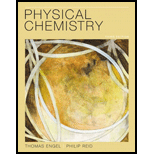
Physical Chemistry Plus Mastering Chemistry With Etext -- Access Card Package (3rd Edition) (engel Physical Chemistry Series)
3rd Edition
ISBN: 9780321766205
Author: Thomas Engel, Philip Reid
Publisher: PEARSON
expand_more
expand_more
format_list_bulleted
Question
Chapter 7, Problem 7.8NP
Interpretation Introduction
Interpretation : The value of z and Vmshould be calculated. The relative error in using Figure 7.8 for this case should be determined.
Concept Introduction :
The molar volume can be calculated from molecular weight and density as follows:
Here,
Also, the compression factor can be calculated as follows:
Here,
Expert Solution & Answer
Want to see the full answer?
Check out a sample textbook solution
Students have asked these similar questions
Indicate the products obtained by mixing 2-Propanone and ethyllithium and performing a subsequent acid hydrolysis.
Indicate the products obtained if (E)-2-butenal and 3-oxo-butanenitrile are mixed with sodium ethoxide in ethanol.
Question 3 (4 points), Draw a full arrow-pushing mechanism for the following reaction
Please draw all structures clearly. Note that this intramolecular cyclization is analogous
to the mechanism for halohydrin formation.
COH
Br
+ HBr
Br
Chapter 7 Solutions
Physical Chemistry Plus Mastering Chemistry With Etext -- Access Card Package (3rd Edition) (engel Physical Chemistry Series)
Ch. 7 - Prob. 7.1CPCh. 7 - Prob. 7.2CPCh. 7 - Prob. 7.3CPCh. 7 - Prob. 7.4CPCh. 7 - Prob. 7.5CPCh. 7 - Prob. 7.6CPCh. 7 - Prob. 7.7CPCh. 7 - Prob. 7.8CPCh. 7 - Prob. 7.9CPCh. 7 - Prob. 7.10CP
Ch. 7 - Prob. 7.11CPCh. 7 - Prob. 7.12CPCh. 7 - Prob. 7.13CPCh. 7 - Prob. 7.14CPCh. 7 - Prob. 7.15CPCh. 7 - Prob. 7.16CPCh. 7 - Prob. 7.17CPCh. 7 - Prob. 7.18CPCh. 7 - Prob. 7.19CPCh. 7 - Prob. 7.20CPCh. 7 - Prob. 7.1NPCh. 7 - Prob. 7.2NPCh. 7 - Prob. 7.3NPCh. 7 - Prob. 7.4NPCh. 7 - Prob. 7.5NPCh. 7 - Prob. 7.6NPCh. 7 - Prob. 7.7NPCh. 7 - Prob. 7.8NPCh. 7 - Prob. 7.9NPCh. 7 - Prob. 7.10NPCh. 7 - Prob. 7.11NPCh. 7 - Prob. 7.12NPCh. 7 - Prob. 7.13NPCh. 7 - Prob. 7.14NPCh. 7 - Prob. 7.15NPCh. 7 - Prob. 7.16NPCh. 7 - Prob. 7.17NPCh. 7 - Prob. 7.18NPCh. 7 - Prob. 7.19NPCh. 7 - Prob. 7.20NPCh. 7 - Prob. 7.21NPCh. 7 - Prob. 7.22NPCh. 7 - Prob. 7.23NPCh. 7 - Prob. 7.24NPCh. 7 - Prob. 7.25NPCh. 7 - Prob. 7.26NPCh. 7 - Prob. 7.27NPCh. 7 - Prob. 7.28NP
Knowledge Booster
Similar questions
- Indicate the products obtained if 2,2-dimethylpropanal and acetaldehyde are mixed with sodium ethoxide in ethanol.arrow_forwardIndicate the products obtained if 2,2-dimethylpropanal and acetaldehyde are reacted with sodium ethoxide in ethanol.arrow_forward2,2-Dimethylpropanal and acetaldehyde are reacted with sodium ethoxide in ethanol. Indicate the products obtained.arrow_forward
- Add conditions above and below the arrow that turn the reactant below into the product below in a single transformationADS fint anditions 百 Abl res condinese NC ง Add on condtions 1.0 B H,N.arrow_forward3. Provide all the steps and reagents for this synthesis. OHarrow_forwardSteps and explanationarrow_forward
- Steps and explanations please.arrow_forwardSteps on how to solve. Thank you!arrow_forward3. Name this ether correctly. H₁C H3C CH3 CH3 4. Show the best way to make the ether in #3 by a Williamson Ether Synthesis. Start from an alcohol or phenol. 5. Draw the structure of an example of a sulfide.arrow_forward
- 1. Which one(s) of these can be oxidized with CrO3 ? (could be more than one) a) triphenylmethanol b) 2-pentanol c) Ethyl alcohol d) CH3 2. Write in all the product(s) of this reaction. Label them as "major" or "minor". 2-methyl-2-hexanol H2SO4, heatarrow_forward3) Determine if the pairs are constitutional isomers, enantiomers, diastereomers, or mesocompounds. (4 points)arrow_forwardIn the decomposition reaction in solution B → C, only species C absorbs UV radiation, but neither B nor the solvent absorbs. If we call At the absorbance measured at any time, A0 the absorbance at the beginning of the reaction, and A∞ the absorbance at the end of the reaction, which of the expressions is valid? We assume that Beer's law is fulfilled.arrow_forward
arrow_back_ios
SEE MORE QUESTIONS
arrow_forward_ios
Recommended textbooks for you
 ChemistryChemistryISBN:9781305957404Author:Steven S. Zumdahl, Susan A. Zumdahl, Donald J. DeCostePublisher:Cengage Learning
ChemistryChemistryISBN:9781305957404Author:Steven S. Zumdahl, Susan A. Zumdahl, Donald J. DeCostePublisher:Cengage Learning ChemistryChemistryISBN:9781259911156Author:Raymond Chang Dr., Jason Overby ProfessorPublisher:McGraw-Hill Education
ChemistryChemistryISBN:9781259911156Author:Raymond Chang Dr., Jason Overby ProfessorPublisher:McGraw-Hill Education Principles of Instrumental AnalysisChemistryISBN:9781305577213Author:Douglas A. Skoog, F. James Holler, Stanley R. CrouchPublisher:Cengage Learning
Principles of Instrumental AnalysisChemistryISBN:9781305577213Author:Douglas A. Skoog, F. James Holler, Stanley R. CrouchPublisher:Cengage Learning Organic ChemistryChemistryISBN:9780078021558Author:Janice Gorzynski Smith Dr.Publisher:McGraw-Hill Education
Organic ChemistryChemistryISBN:9780078021558Author:Janice Gorzynski Smith Dr.Publisher:McGraw-Hill Education Chemistry: Principles and ReactionsChemistryISBN:9781305079373Author:William L. Masterton, Cecile N. HurleyPublisher:Cengage Learning
Chemistry: Principles and ReactionsChemistryISBN:9781305079373Author:William L. Masterton, Cecile N. HurleyPublisher:Cengage Learning Elementary Principles of Chemical Processes, Bind...ChemistryISBN:9781118431221Author:Richard M. Felder, Ronald W. Rousseau, Lisa G. BullardPublisher:WILEY
Elementary Principles of Chemical Processes, Bind...ChemistryISBN:9781118431221Author:Richard M. Felder, Ronald W. Rousseau, Lisa G. BullardPublisher:WILEY

Chemistry
Chemistry
ISBN:9781305957404
Author:Steven S. Zumdahl, Susan A. Zumdahl, Donald J. DeCoste
Publisher:Cengage Learning

Chemistry
Chemistry
ISBN:9781259911156
Author:Raymond Chang Dr., Jason Overby Professor
Publisher:McGraw-Hill Education

Principles of Instrumental Analysis
Chemistry
ISBN:9781305577213
Author:Douglas A. Skoog, F. James Holler, Stanley R. Crouch
Publisher:Cengage Learning

Organic Chemistry
Chemistry
ISBN:9780078021558
Author:Janice Gorzynski Smith Dr.
Publisher:McGraw-Hill Education

Chemistry: Principles and Reactions
Chemistry
ISBN:9781305079373
Author:William L. Masterton, Cecile N. Hurley
Publisher:Cengage Learning

Elementary Principles of Chemical Processes, Bind...
Chemistry
ISBN:9781118431221
Author:Richard M. Felder, Ronald W. Rousseau, Lisa G. Bullard
Publisher:WILEY